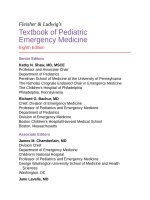Pediatric emergency medicine trisk 1459 1459
Bạn đang xem bản rút gọn của tài liệu. Xem và tải ngay bản đầy đủ của tài liệu tại đây (100.05 KB, 1 trang )
may be lacking, and physical examination may reveal only lethargy. Elevation of
the carboxyhemoglobin level is diagnostic.
Renal Disorders (See Chapter 100 Renal and Electrolyte
Emergencies )
A young infant may also appear extremely ill because of renal failure or
dysplasia. Posterior urethral valves, especially in males, can cause bladder outlet
obstruction and resultant renal failure. Approximately one-third of these cases are
diagnosed by 1 week of age, but more than half go undetected for the first few
months of life. The parents may give a history of vomiting, poor appetite,
inadequate weight gain, or an abdomen that appears swollen. A careful review of
systems may reveal a weak urinary stream. On physical examination,
hypertension or an abdominal mass (hydronephrosis) may be detected, as well as
urinary ascites. A suprapubic ultrasound may demonstrate the dilated posterior
urethra and bladder and a voiding cystourethrogram will show a dilated posterior
urethra, hypertrophy of the bladder neck, and trabeculated bladder. The serum
creatinine and blood urea nitrogen levels may be markedly elevated. Urosepsis is
a possible complication of posterior urethral valves.
Hematologic Disorders
Any infant with severe anemia caused by aplastic disease, hemolytic process, or
blood loss can look quite ill (see Chapter 93 Hematologic Emergencies ).
Disorders of hemoglobin such as methemoglobinemia can also cause an infant to
appear toxic and may be inherited or acquired. Transient methemoglobinemia in
infants is occasionally caused by environmental toxicity from oxidizing agents
such as nitrates found in well water or oxidant drugs (e.g., topical benzocaine in
teething gels). This intoxication presents with cyanosis, poor feeding, failure to
thrive, vomiting, diarrhea, and lethargy. In other patients, the oxidant stress is less
obvious, causing severe diarrhea and metabolic acidosis. It is postulated that the
infectious agent that causes the diarrhea or the secondary metabolic acidosis may
produce an oxidant stress that leads to methemoglobin formation. These infants
are lethargic, with hypothermia, tachycardia, tachypnea, and hypotension, and
often appear mottled, cyanotic, or ashen. One key to the diagnosis of
methemoglobinemia is that oxygen administration does not affect the cyanosis
(similar to CHD with right-to-left shunt). Laboratory tests show a profound
acidosis (pH 6.9 to 7.2), yet the PaO 2 is normal despite the cyanosis.
Leukocytosis and thrombocytosis are present, and prerenal azotemia may be
noted. The blood itself may appear chocolate brown (most easily noted when a
drop of blood on filter paper is waved in the air and compared with a normal









